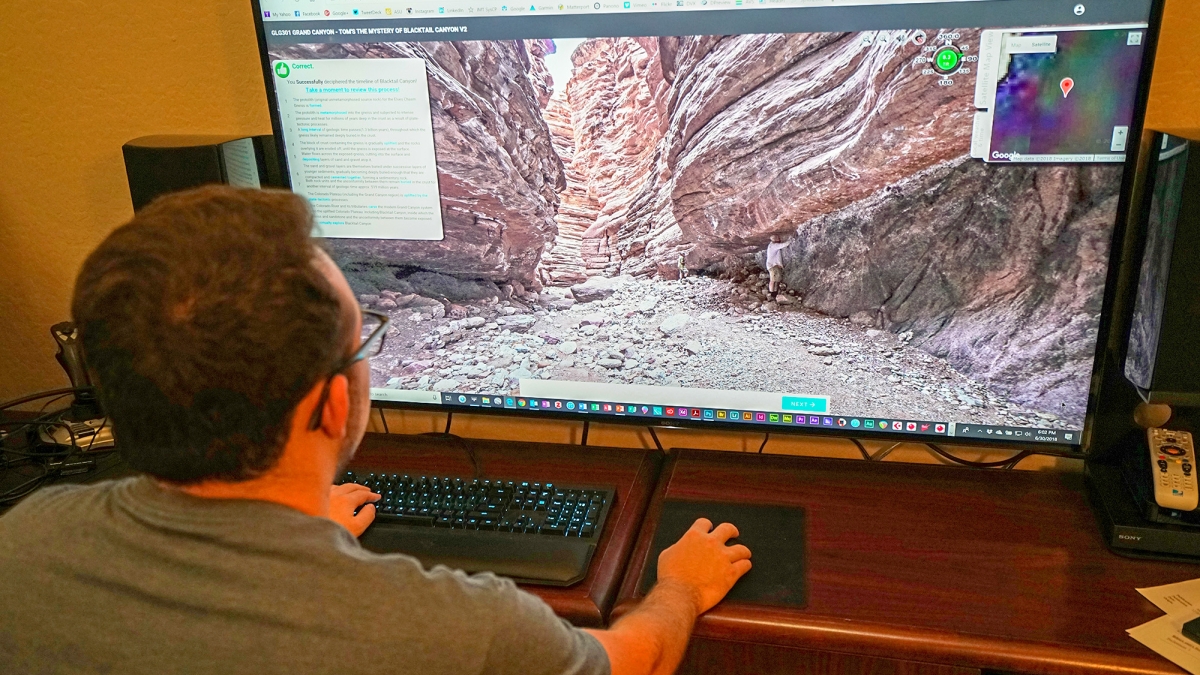Inspiring sustainability action through virtual field trips

Exploring the Grand Canyon through a virtual field trip. Photo courtesy Rimjhim Aggarwal
Arizona State University sustainability scientists Rimjhim Aggarwal and Ariel Anbar were recently awarded a grant that enables the professors to pilot a project that will train students to create virtual field trips as a way to narrate their own place-based stories regarding the United Nations Sustainable Development Goals (SDGs) and share with peers globally to motivate youth action.
Aggarwal and Anbar are uniquely qualified to run such a project. Aggarwal, an associate professor in the School of Sustainability, brings her expertise in global development. Anbar, a President’s Professor in the School of Earth and Space Exploration and School of Molecular Sciences who directs the ASU Center for Education Through eXploration, has worked on virtual field trips, or VFTs, for nearly a decade.
VFTs are online, immersive experiences that allow users to explore various aspects of a topic or place using 360-degree imagery, videos, photos, sounds and other media. Typically, VFTs are produced so people can visit places that are difficult, dangerous or expensive to access, or are too fragile or sacred to handle many visitors. Because VFTs offer many different elements to investigate, users can choose what to learn more about and this “learning by exploration” experience is different for each person.
Until now, only trained professionals have been able to create VFTs, so this valuable resource is underdeveloped. Streamlining the process to enable college students to make them will allow many more topics and stories to be explored, not just by ASU students but also by youth around the world.
“We are excited to expand the concept of ‘learning by doing’ to include learners creating their own virtual field trips,” Anbar said. “Empowering learners to be creators, not just consumers, of immersive, interactive digital resources is a key next step in education technology.”
Storytelling is another fundamental aspect of this project. As Aggarwal explained, stories have the potential to drive social change.
“They appeal to us on a core emotional level, and research shows that stories can be more effective than facts or conventional pedagogy in influencing thinking and behavior,” she said. “However, not all stories have that power to connect and drive change. Although storytelling is an ancient art, new technologies offer many interesting possibilities to create and share stories that are compelling.”
Undergraduate and graduate students in any major are encouraged to enroll in the spring 2019 workshop course called “Creating Virtual Field Trips for Global Development.” In the course, led by Aggarwal in collaboration with staff from the Center for Education through eXploration, students will learn how to make VFT prototypes — a process that includes creating storyboards and using technology to tell stories about the SDGs. The class begins Jan. 8.
The spring-semester class is only the beginning of the project. In the summer, students will have the opportunity to travel throughout the American Southwest to create VFTs, and in the fall semester the VFTs will be globally shared on social media, in classes around the world and on educational platforms, while being tracked to document the value of these innovative learning tools. The grant funding will end in spring 2020, so Aggarwal and Anbar will wrap everything up earlier that year.
In their virtual storytelling, students will focus on SDGs one through six: no poverty, zero hunger, good health and well-being, quality education, gender equality, and clean water and sanitation. Though these issues are vast and complex, they can be felt and understood on a personal level. Aggarwal said she will challenge students to tell visceral stories that VFT users can relate to — which will hopefully encourage them to take action and think about solutions.
“There is a lot of information about the SDGs — in fact, there is an information overload,” Aggarwal said. “The problem is not that we don’t have information. The problem is how to motivate action. I think a prerequisite to taking action is making a personal connection.”
The fact that young people will be creating for other young people is key to this connection. As Aggarwal noted, she and her teenage daughter have a different way of understanding and relating to things. If Aggarwal, Anbar and the team want a younger generation to take action toward creating a more sustainable world, then young people all over the globe need to be involved in producing the VFTs based on their own personal experiences.
“For global development, we need to have diverse stories and empower young people everywhere — not just the experts — to create these stories,” Aggarwal said.
More Science and technology

ASU-led space telescope is ready to fly
The Star Planet Activity Research CubeSat, or SPARCS, a small space telescope that will monitor the flares and sunspot activity…

ASU at the heart of the state's revitalized microelectronics industry
A stronger local economy, more reliable technology, and a future where our computers and devices do the impossible: that’s the…

Breakthrough copper alloy achieves unprecedented high-temperature performance
A team of researchers from Arizona State University, the U.S. Army Research Laboratory, Lehigh University and Louisiana State…

